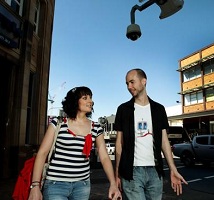A recent study by security firm Protection1 discovered over 6,000 no-password, open-access security cameras spread across the US. According to the company’s findings, many of these cameras are located in public places, at the headquarters of private enterprises, and even in the homes of many Americans. Protection1 notes that the highest concentration of unprotected cameras is around big urban centers, such as the San Francisco Bay area, the Los Angeles area, Seattle, Chicago, the Florida cities, and all over the Atlantic coast, from Washington DC to Boston. These towns are the centers of many security hot spots, like airports, military bases, and hospitals, so the large number of unprotected cameras should ring alarm bells with the people in charge of those systems. Protection1 also ranked the number of unprotected cameras per 100,000 residents and came up with the top ten cities with the largest density of open-access cameras.
Leading the pack is the small town of Walnut Creek, California, with 89.69 open-access cameras per 100,000 citizens. The other towns in this top ten list were also small-to-medium cities, and Protection1 believes that the lack of critical security needs in these smaller towns has allowed authorities to relax when it comes to the e-security of these systems.
In regards to states, North Dakota was leading the top ten with 7.79 unsecured cameras per 100,000 residents. The rest of the top ten listed states with a smaller population density, and with no security hot spots to protect. Unlike the cities top ten, there was a surprise in the top ten states ranking. The District of Columbia came second, with 5.8 cameras per 100,000 residents.
“Considering the sensitive nature of life in our nation’s capital, one would hope that Washington’s security camera feeds were password protected,” Protection1 analysts note. Breaking down the data even further, Protection1 experts also took a look at what these cameras are pointing at. From the total of over 6,000 cameras they analyzed, 21.55 percent were watching outdoor environments and parks, and 21.18 percent were surveilling parking lots. Not necessarily security hot points, but still, a password would have been nice. The third on this list is a little bit worrisome because researchers discovered 15.04 percent of all the unsecured cameras were installed in homes, either as baby monitors, home security feeds, doorbell cameras, or other IoT devices.








